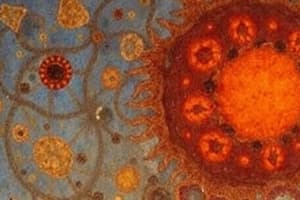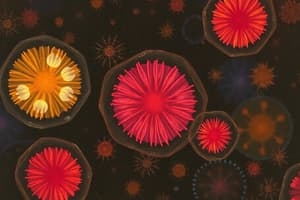Podcast
Questions and Answers
Which cellular component is primarily responsible for the production of ATP through cellular respiration?
Which cellular component is primarily responsible for the production of ATP through cellular respiration?
- Mitochondrion (correct)
- Golgi Apparatus
- Ribosome
- Endoplasmic Reticulum
In the central dogma of molecular biology, what is the correct flow of genetic information?
In the central dogma of molecular biology, what is the correct flow of genetic information?
- DNA → Protein → RNA
- RNA → DNA → Protein
- Protein → RNA → DNA
- DNA → RNA → Protein (correct)
In an ecosystem, what role do decomposers play in nutrient cycling?
In an ecosystem, what role do decomposers play in nutrient cycling?
- Converting sunlight into chemical energy.
- Consuming other organisms for energy.
- Breaking down dead organic matter to release nutrients. (correct)
- Producing oxygen through photosynthesis.
Which of the following processes leads to the formation of new species?
Which of the following processes leads to the formation of new species?
What is the primary function of ribosomes within a cell?
What is the primary function of ribosomes within a cell?
Which of the following best describes the role of tRNA in protein synthesis?
Which of the following best describes the role of tRNA in protein synthesis?
What is the significance of the complementary base pairing rules (A with T, and C with G) in DNA?
What is the significance of the complementary base pairing rules (A with T, and C with G) in DNA?
Which of the following is an example of a biotic factor in an ecosystem?
Which of the following is an example of a biotic factor in an ecosystem?
What is the primary role of natural selection in the process of evolution?
What is the primary role of natural selection in the process of evolution?
Which of the following best describes the concept of homeostasis in physiology?
Which of the following best describes the concept of homeostasis in physiology?
Flashcards
What is Biology?
What is Biology?
The scientific study of life, including structure, function, growth, origin, evolution, distribution, and taxonomy of living organisms.
What is a Cell?
What is a Cell?
The basic unit of life, studying its structure, function, and behavior.
What is the Plasma Membrane?
What is the Plasma Membrane?
Selectively permeable barrier controlling the movement of substances into and out of the cell.
What are Organelles?
What are Organelles?
Signup and view all the flashcards
What is Genetics?
What is Genetics?
Signup and view all the flashcards
What are Genes?
What are Genes?
Signup and view all the flashcards
What are Mutations?
What are Mutations?
Signup and view all the flashcards
What is Ecology?
What is Ecology?
Signup and view all the flashcards
What is Evolution?
What is Evolution?
Signup and view all the flashcards
What are Anatomy and Physiology?
What are Anatomy and Physiology?
Signup and view all the flashcards
Study Notes
- Biology is the scientific study of life
- It explores the structure, function, growth, origin, evolution, distribution, and taxonomy of living organisms
- Biology encompasses a wide range of fields, including anatomy, physiology, cell biology, genetics, ecology, and evolutionary biology
Cell Biology
- The cell is the basic unit of life
- Cell biology studies the structure, function, and behavior of cells
- Key components of cells include the plasma membrane, cytoplasm, and nucleus (in eukaryotic cells)
- The plasma membrane is a selectively permeable barrier that controls the movement of substances into and out of the cell
- The cytoplasm consists of the cytosol (fluid) and organelles
- Organelles are structures within the cell that perform specific functions (e.g., mitochondria for energy production, ribosomes for protein synthesis)
- Eukaryotic cells have a nucleus, which contains the cell's DNA, while prokaryotic cells lack a nucleus
- Cell division processes include mitosis (for growth and repair) and meiosis (for sexual reproduction)
Genetics
- Genetics is the study of heredity and variation in living organisms
- Genes are the basic units of heredity, composed of DNA (deoxyribonucleic acid)
- DNA carries the genetic information that determines an organism's traits
- The structure of DNA is a double helix, with nucleotide bases (adenine, guanine, cytosine, and thymine) pairing specifically (A with T, and C with G)
- The central dogma of molecular biology describes the flow of genetic information: DNA → RNA → Protein
- RNA (ribonucleic acid) is involved in protein synthesis
- Mutations are changes in the DNA sequence that can lead to variations in traits
- Mendelian genetics describes the principles of inheritance, including dominant and recessive alleles
- Genetic engineering involves manipulating an organism's genes to alter its traits
Ecology
- Ecology is the study of the interactions between organisms and their environment
- An ecosystem consists of all the living organisms (biotic factors) in a particular area, as well as the non-living components (abiotic factors) such as air, water, and soil
- Populations are groups of individuals of the same species living in the same area
- Communities are groups of different populations living and interacting in the same area
- Energy flows through ecosystems via food chains and food webs
- Producers (e.g., plants) convert sunlight into chemical energy through photosynthesis
- Consumers (e.g., animals) obtain energy by feeding on other organisms
- Decomposers (e.g., bacteria and fungi) break down dead organic matter, recycling nutrients back into the ecosystem
- Biogeochemical cycles (e.g., carbon cycle, nitrogen cycle) describe the movement of essential elements through ecosystems
- Human activities can have significant impacts on ecosystems, including pollution, deforestation, and climate change
Evolutionary Biology
- Evolution is the process by which populations of organisms change over time
- Natural selection is a mechanism of evolution, where individuals with traits that are better suited to their environment are more likely to survive and reproduce, passing on those traits to their offspring
- Adaptations are traits that enhance an organism's survival and reproduction in a specific environment
- Speciation is the process by which new species arise
- Evidence for evolution includes fossils, comparative anatomy, embryology, and molecular biology
- Phylogeny is the study of the evolutionary relationships between organisms
- The tree of life represents the evolutionary history of all living organisms
Anatomy and Physiology
- Anatomy is the study of the structure of living organisms
- Physiology is the study of the function of living organisms
- Organisms are organized into different levels of complexity: cells, tissues, organs, and organ systems
- Tissues are groups of similar cells that perform a specific function (e.g., muscle tissue, nervous tissue)
- Organs are structures composed of different tissues that work together to perform a specific function (e.g., heart, brain)
- Organ systems are groups of organs that work together to perform a major bodily function (e.g., digestive system, respiratory system)
- Homeostasis is the maintenance of a stable internal environment in the body
- Feedback mechanisms regulate physiological processes to maintain homeostasis
Studying That Suits You
Use AI to generate personalized quizzes and flashcards to suit your learning preferences.




